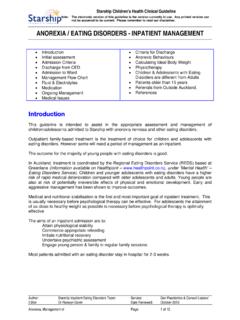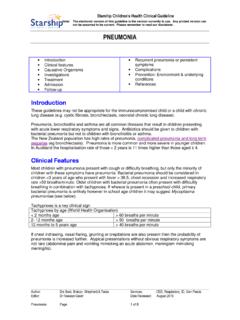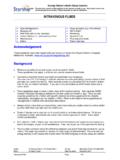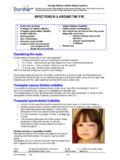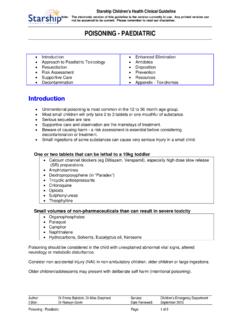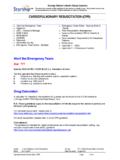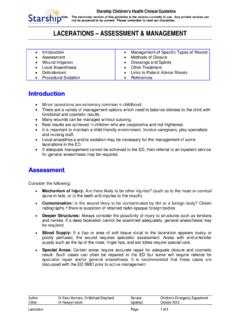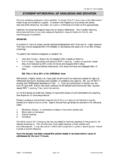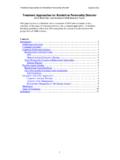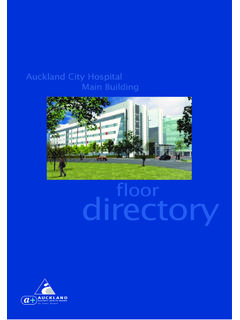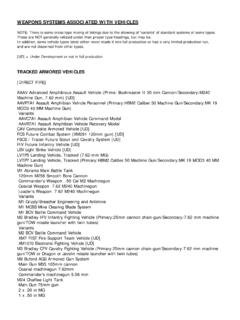Transcription of HEAD INJURY, MANAGEMENT OF PAEDIATRIC
1 starship Children s Health Clinical Guideline Note: The electronic version of this guideline is the version currently in use. Any printed version can not be assumed to be current. Please remember to read our disclaimer. head injury , MANAGEMENT OF PAEDIATRIC Author: Dr Andrew Law, Dr Fran Settle Service: PAEDIATRIC Neurosurgery, CED. Editor: Dr Raewyn Gavin Date Reviewed: February 2009 head injury , MANAGEMENT of PAEDIATRIC Page: 1 of 22 Introduction Primary Survey o Glasgow Coma Score o AVPU Categories of Severity Initial MANAGEMENT Flow Chart Secondary Survey Moderate & Severe head injury (GCS 13) Minor head injury (GCS 14-15)
2 O < 2 years o 2-15 years Criteria for Admission or Discharge Inpatient MANAGEMENT of Mild head injury Fluid MANAGEMENT Guidelines on Drug Usage Detailed Guidelines for Head Imaging Transfer from Peripheral Hospital Base of Skull Fracture Post-traumatic seizure Post-concussion syndrome Appendix 1: Glasgow Coma Scale (detailed) Appendix 2: head injury - Instructions for Parents Appendix 3: head injury in Infants - Instructions for Parents References IntroduIntroduIntroduIntroductionctionct ionction These Guidelines have been created in an attempt to create consistency in the MANAGEMENT of head injuries in children with the following goals: Identification of at risk patients and utilisation of early CT scanning Avoidance of Skull x-ray as diagnostic tool in head injury assessment Minimise secondary injury .
3 Use of discharge after Normal CT scanning if clinically appropriate and carer available with access to phone and transport. Identification of infants at risk from abuse or neglect. In some series, child abuse accounts for 25% or more of admissions for head injury in children under 2 years. Any child who may have sustained a head injury (traumatic brain injury or skull fracture) should undergo initial assessment in the same structured manner as any other trauma patient (see Trauma Guideline) Primary SurveyPrimary SurveyPrimary SurveyPrimary Survey A Assess and secure airway whilst ensuring cervical spine immobilisation B Assess breathing and give high flow oxygen by mask C Assess circulation, obtain IV access, and commence fluid resuscitation if indicated (signs of hypovolaemia)
4 D Determine conscious level using GLASGOW COMA SCALE or AVPU scale (note any asymmetry in limb response), and examine pupil size, symmetry and reaction to light. E Check blood glucose level, treat if low starship Children s Health Clinical Guideline Note: The electronic version of this guideline is the version currently in use. Any printed version can not be assumed to be current. Please remember to read our disclaimer. head injury , MANAGEMENT OF PAEDIATRIC Author: Dr Andrew Law, Dr Fran Settle Service: PAEDIATRIC Neurosurgery, CED. Editor: Dr Raewyn Gavin Date Reviewed: February 2009 head injury , MANAGEMENT of PAEDIATRIC Page: 2 of 22 Notes Good oxygenation and circulatory resuscitation are essential to avoid further brain injury (secondary brain injury ).
5 The presence of hypotension should be considered an emergency. If possible the neurological status should be reassessed following treatment of hypoxaemia and hypotension. The best GCS after resuscitation is used for classification of the severity of head injury . Intubation (after induction of anaesthesia) and mechanical ventilation may be required as part of steps A or B during the primary survey. However, for the patient who has been brought in by ambulance unintubated there is almost always sufficient time (30 60 seconds) to assess their neurological status (step D) prior to intubation.
6 Establishing the mechanism of injury is important in assessing the risk of head and/or spinal injury . Glasgow Coma Scale (GCS) A more detailed version of the GCS for use in infants can be found in Appendix 1 GLASGOW COMA SCALE EYE OPENING MOTOR RESPONSE VERBAL RESPONSE 4 spontaneous 6 obeys commands 5 orientated 3 to voice 5 localises to pain 4 confused 2 to pain 4 flexion withdrawal 3 inappropriate 1 no response 3 abnormal flexion 2 incomprehensible 2 extension 1 no response 1 no response To obtain a GCS score add the points from each of the three categories together. (Minimum = 3, Maximum = 15).
7 Points in each category should reflect the best response in a given time period. AVPU AVPU is a quick and simple assessment of neurological state. It is essentially the same as determining the motor response of the GCS. It may be useful in young (pre-verbal) children. AVPU (for children under 2 years old) Alert Responds to Voice Responds to Pain purposeful localises non-purposeful withdrawal, abnormal flexion or extension Unresponsive starship Children s Health Clinical Guideline Note: The electronic version of this guideline is the version currently in use.
8 Any printed version can not be assumed to be current. Please remember to read our disclaimer. head injury , MANAGEMENT OF PAEDIATRIC Author: Dr Andrew Law, Dr Fran Settle Service: PAEDIATRIC Neurosurgery, CED. Editor: Dr Raewyn Gavin Date Reviewed: February 2009 head injury , MANAGEMENT of PAEDIATRIC Page: 3 of 22 Categories of severityCategories of severityCategories of severityCategories of severity The severity of head injury (as mild, moderate or severe) will determine further MANAGEMENT (see flow chart below). If at any stage there is doubt about the MANAGEMENT of a patient, then discussion with senior colleagues is essential.
9 Be aware that deterioration can be rapid and reassessment may be required at any stage. Severe Head Injuries GCS 3-8 AVPU Unresponsive or non-purposeful response to pain Moderate Head Injuries GCS 9-13 AVPU Purposeful response to pain or better Mild Head Injuries GCS 14-15 AVPU Alert or responds to voice head injury head injury head injury head injury ---- Initial MANAGEMENT Flow Chart Initial MANAGEMENT Flow Chart Initial MANAGEMENT Flow Chart Initial MANAGEMENT Flow Chart Primary Survey & ResuscitationSEVERE HEAD INJURYGCS = 3-8 AVPU = Unresponsive or non-purposeful response to painASSESS SEVERITY OF head injury using
10 Glasgow Coma Score (or AVPU if < 2 years of age)MILD HEAD INJURYGCS = 14-15 AVPU = Alert or responds to voiceMODERATE head injury or FOCAL NEUROLOGYGCS = 9 13 AVPU = Purposeful response to pain or betterTRAUMA STAT CallIntubate with cervical spine immobilisationArrange URGENT CT head & NeckConsult Neurosurgery & PICUC omplete Secondary SurveySee further detail belowTRAUMA STAT CallArrange URGENT CT head +/- neckConsult NeurosurgeryComplete Secondary SurveySee further detail belowComplete Secondary SurveySee further detail in Mild HI Algorithms below according to age starship Children s Health Clinical Guideline
